Helsinki
The "Daughter of the Baltic", Helsinki (Finnish) (Helsingfors in Swedish) is Finland's capital and largest city. Founded in 1550, Helsinki became the capital of the Finnish Grand Duchy in 1812, when the Russian Empire rebuilt it as a miniature St. Petersburg, a role it has played in many a Cold War movie. Today, Helsinki is a city of 600,000 people, combining the atmosphere of an international metropolis with the coziness of a small town. The city is best seen during its short summers, when the sun brings the outdoor bars and cafés to life and even the nights are light. While visiting in winter is more of a challenge, Helsinki is one of few large cities in Europe with a good chance for snow on Christmas.
Districts
The city of Helsinki forms the core of Finland's largest urban area, known in Finnish as the "capital area" (pääkaupunkiseutu). Helsinki is bordered by the Gulf of Finland to the south, while the posh suburban city of Espoo, with the embedded tiny enclave city of Kauniainen, is to the west. The more industrialized city of Vantaa is to the north and east. The Capital Region has a population of about 1.1 million, 630,000 of them living in Helsinki proper. Beyond these, the suburbs rapidly give way to small towns, farms and forests, most notably Nuuksio National Park at the intersection of Espoo, Vihti and Kirkkonummi.
Helsinki's city center is on the southern peninsula at the end of the city's main thoroughfare Mannerheimintie (or just Mansku). The central railway station and the main bus terminal are in the city center. Shopping streets Aleksanterinkatu (or Aleksi for short) and Esplanadi (or Espa) connect to Senate Square (Senaatintori), the historical center of the city. See the Helsinki Guide Map for an interactive searchable map of the city.
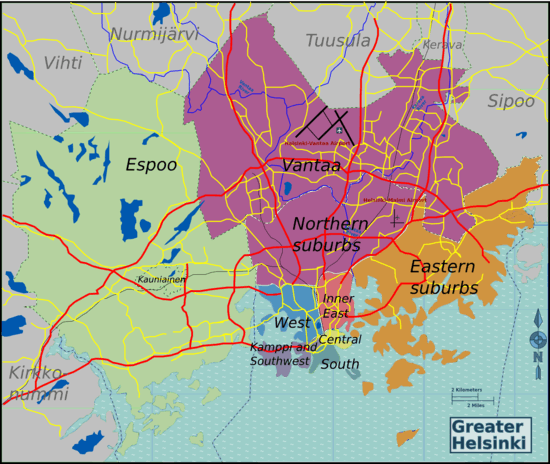
| Central Probably half of Helsinki's points of interest are downtown. The Lutheran Cathedral with the surrounding buildings, dating from the early 19th century when Helsinki was made capital of the Grand Duchy of Finland, can be found here. Westwards there is what can be called the central business district with shopping and dining along the streets of Aleksanterinkatu and Mannerheimintie. |
| South In the calm and affluent southern part of Helsinki you can enjoy the greenery of the parks and drop into a nice café for a cuppa coffee. Suomenlinna, the fortress on an island, is a UNESCO World Heritage Site. |
| Kamppi and Southwest For some great places for eating and drinking, head across Mannerheimintie and continue through Kamppi. Further west the former industrial part of the city, watched over by the cranes of the shipyard and industry chimneys you can nowadays glance over the modern architecture and out to the sea. |
| West The western part of the city is a great getaway from the hustle and bustle of the city center. If you have the time, take a leisurely seaside stroll along the shores of Laajalahti bay, or if you're a sports buff, visit the great summer and winter sports venues which are concentrated in this part of the city. The list cultural and historical sights of western Helsinki isn't bad either - it hosts the National Opera, Hietalahti cemetery, the Church in the Rock, the museums of Natural History, Finland's National Museum and the home of the long-time president Urho Kekkonen. |
| Inner East If you, on the other hand, are interested in the more bohemian part of Helsinki and/or love to party you'd better head to the Inner East and districts like Kallio. The former working class part of the city is still associated with counterculture and to some extent left-wing politics and is largely inhabited by students. Kallio is as close as one could come to a "red light district" in Helsinki. However, the Inner East part of the city also hosts the amusement park Linnanmäki and the old wooden neighborhoods of Vallila and Käpylä. |
| Eastern suburbs The eastern parts of Helsinki is mostly residential and probably the most culturally diverse part of the city, as immigrants from many parts of the world live here. In this part of Helsinki you can find the Helsinki Zoo, the huge shopping complex Itis, Finland's tallest residential building in Vuosaari as well as the northernmost metro station in the world in Mellunmäki. |
| Northern suburbs The northern parts of Helsinki consists of highways, shopping malls and residential buildings. It connects seamlessly to the next city north of Helsinki - Vantaa. While not as culturally interesting as the other parts of Helsinki, it offers some natural attractions like the Central Park and Helsinki's highest point Malminkartanonhuippu. |
Understand
History
- See also: Nordic history
As Finland became part of the Swedish kingdom in the 13th century with Turku as its regional capital, Helsinki was founded in AD 1550 by King Gustav Vasa of Sweden as a trading post to compete with Tallinn to the south in Estonia, which was Danish at that time. Helsinki was established about 5 km northeast of the current downtown, at the rapids where Vantaa river (at that time known as Helsinge river) flows into the Baltic Sea, which in turn gave the city its Swedish name Helsingfors. Never becoming the trading post Gustav Vasa envisioned and largely bypassed by the King's Road — the major road along the coast at that time — the village faced some hard times during its first centuries with fires and diseases and today there is but a few stones left of the original Helsinki. Eventually the city was moved further south to its current location and in the middle of 18th century Sveaborg (nowadays Suomenlinna in Finnish) Maritime Fortress was established in the front of Helsinki. The now world heritage-listed fortress archipelago features some of the oldest standing buildings in the city.
In 1809, Finland was annexed by Russia after the Finnish War (a part of the Napoleonic Wars), and the capital of Finland moved from Turku to Helsinki in 1812.The Czar felt the Grand Duchy of Finland needed a capital of grand proportions, and this was a major turning point in the history of Helsinki. The architects Johan Albrecht Ehrenström, a native Finn, and Carl Ludwig Engel, from Germany, were given the task of rebuilding the city in the Empire style. This can be seen today around the Lutheran Cathedral, which was completed in 1852. The same style, and even architects, is also a part of Saint Petersburg's history.
Growing steadily during the 19th century, with the population exceeding 100,000 by the turn of the century, Helsinki had established itself as the largest city and ad the political and cultural capital of the country. The city was a battleground in the Finnish Civil War 1917-18, and was bombed by the Soviets in the Second World War. Before the war Finland was largely an agricultural country but the industrialization and urbanization that happened during the following decades meant an influx of new inhabitants from the rural parts of the country and turned Helsinki into the metropolis it is today with suburbs, superhighways and even a small subway system. Architectonically a young city, many of the monumental buildings erected since the independence have a stark modernist style and the rest of the city's architecture is made up of National Romantic style buildings from the early 20th century and the aforementioned Empire style buildings in Central Helsinki. Though thoroughly a Nordic capital, Helsinki today reflects the influences gained from the Western and Eastern cultures.
Tourist information
🌍 City of Helsinki Tourist Information Office, Corner of Pohjoisesplanadi and Unioninkatu (just off Market Square), ☎ +358 9 3101-3300. M-F 09:00-20:00, Sa Su 09:00-18:00; Oct-Apr closes 18:00/16:00. A fount of information with helpful, multilingual staff. They also sell tickets to museums and sightseeing tours. There is also another one right in the Central Railway Station.
Climate
| Helsinki | ||||||||||||||||||||||||||||||||||||||||||||||||||||||||||||
|---|---|---|---|---|---|---|---|---|---|---|---|---|---|---|---|---|---|---|---|---|---|---|---|---|---|---|---|---|---|---|---|---|---|---|---|---|---|---|---|---|---|---|---|---|---|---|---|---|---|---|---|---|---|---|---|---|---|---|---|---|
| Climate chart (explanation) | ||||||||||||||||||||||||||||||||||||||||||||||||||||||||||||
| ||||||||||||||||||||||||||||||||||||||||||||||||||||||||||||
| ||||||||||||||||||||||||||||||||||||||||||||||||||||||||||||
Helsinki is among the world's northernmost capitals and the lengthy winter is dark and chilly. Winter temperatures average −5 °C (23 °F), but the wind chill and humidity makes it feel even colder and the mercury can plunge below −20 °C (−4 °F) on a particularly cold day. Days are short. In general snow falls only intermittently and often melts into grey slush. However lake-effect snowfalls dropping copious amounts of snow during a few hours (and messing up the traffic) is not unheard of in the early winter. Since the Helsinki peninsula juts into the sea, there is often a cold sea wind, and the climate is more maritime than inland, with snow and −5 °C (23 °F) replaced by slush, sleet and 0 °C (32 °F). This is especially apparent in November and December, but the first months of the year almost always have colder temperatures and clear skies.
The spring brings clear skies but the temperature doesn't increase as fast as the sunshine hours; even in April you may experience sub-zero nights, even as the afternoon temperatures raise above 10 °C (50 °F). The summer is often pleasant. Daytime temperatures are usually around 20 °C (68 °F) and July and August afternoons often see temperatures above 25 °C, and unlike the rest of the year you don't need a jacket or sweater even at nighttime. The sun sets late in the night and even then dusk turns into dawn without any real darkness in between. Parks burst into green, sunbathers dot the city's beaches and restaurants and bars deploy their terraces and patios, making the streetscape look more Central European for a couple of months. The autumn slowly developes throughout September with fall foliage and moderate temperatures; snow and seriously cold weather before early November is very uncommon.
Talk
The city is officially bilingual, with an 86% Finnish-speaking majority and a visible 6% Swedish-speaking minority. Many in the Finnish-speaking majority only know the basics of Swedish, which they learned in school, while some speak it fluently.
The majority of Finnish-speaking people are much more comfortable with speaking English than Swedish, and especially the younger generations usually speak very good English. Although locals will appreciate an effort to say a few words in Finnish, they know very well how difficult Finnish is and will readily switch to English – many people also like the chance to practice their English.
Finnish letters are always pronounced the same way, regardless of context (unlike e.g. English "a" in "car" and "hat"), with letters doubled for long sounds. Word stress is always on the first syllable. This makes it easy to learn how words should be pronounced, while actually pronouncing them correctly may be quite difficult.
Street signs and most other signs are usually in both Finnish and Swedish. In tourist-oriented areas, English signage is also prevalent. The Finnish and Swedish names for different streets and areas in Helsinki may differ significantly, for example Suomenlinna/Sveaborg for the fortress or Pasila/Böle for one of the train stations.
Being Finland's most cosmopolitan area by a fair margin, Helsinki also houses people from different parts of the world. While strolling around, you may hear people converse in Estonian (which at first sounds a lot like Finnish), Russian, German, and Somali.
Get in
By plane
- Main article: Helsinki Airport
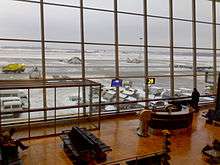
All international and domestic flights land at the compact, modern and airy 🌍 Helsinki Airport (HEL IATA). which is in Vantaa, 20 km to the north of central Helsinki.
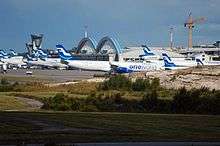
Helsinki Airport is of particular note for its connections to East Asia, as it is on the Great Circle Route, the shortest route between East Asia and Europe. Therefore, the connections between Helsinki and the region take between 7 and 10 hours and are comparable to flight times to Persian Gulf hubs in Dubai, Abu Dhabi and Doha. The important difference, however, is that most major European cities are between 2 and 3 hours flight time from Helsinki (and much less that for Scandinavia and the Baltic countries), whereas getting to Europe from the Persian Gulf takes 5 to 8 hours. There is also the benefit of the airline being able to "turn around" the plane within 24 hours (the aircraft completes both the flight from origin to destination and back), which is a significant cost advantage and may be passed on to passengers.
The Finnish flag carrier, Finnair (a oneworld member), takes full advantage of it, offering a multitude regular flights to Asia, including Beijing, Seoul Incheon, Shanghai and Tokyo, but also destinations like Chongqing, Nagoya or Osaka. Outside of East Asia, Finnair also serves India, Israel, Singapore, Thailand, United Arab Emirates and Vietnam. In the other direction, New York City is served around the year and Chicago, Miami and San Francisco in the summer season.
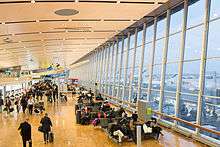
Except for charter airlines, Finnair and oneworld partners JAL (from Tokyo) and Qatar (from Doha) are the only airlines offering long-haul flights from Helsinki Airport. That said, the airport is very well served by Finnair and other European airlines, with connections not only to major hubs but also many other airports across the continent, so that you can find more intercontinental flights with a connection to Helsinki as well as travel to and from Helsinki across Europe comfortably. Of yet another note is Helsinki's proximity to Russia, of which Finnair also takes advantage by offering an unusually wide selection of direct flights there. (Kazan, Moscow, Saint Petersburg, Samara and Yekaterinburg)
There are nominally two adjacent terminals at Helsinki Airport, although in practice they are part of the same building. They are used by the following airlines:
- T1: Star Alliance (but excluding Turkish Airlines in T2) and a few airlines not part of any alliance.
- T2: Finnair and all other oneworld airlines, SkyTeam airlines (Aeroflot, KLM) and Norwegian Air Shuttle. All flights outside the Schengen area use terminal 2.
Minor carriers are distributed between those two terminals without a pattern.
The airport is more crowded than it used to be, so prepare for delays when going through security, particularly during the holiday periods like the school's winter break in late February, Easter and Christmas, and to some extent the summer holiday period from mid-June to mid-August. If you are flying a budget carrier or an airline with one flight a day or less (e.g. Icelandair), you are urged to arrive at the recommended time (to be on the safe side, about 2½ hours prior to departure) since they have fewer check-in agents. Nevertheless, the situation is seldom comparable to, say, Heathrow or Frankfurt Airport. The terminal building is undergoing significant expansion to alleviate the stress.
From Vantaa Airport to the city
Regular taxis to the centre cost €40–50. Shared Airport Taxi (tel. +358 600-555-555 for bookings) mini-vans start from €29 for two (infants count as an adult).
There are some taxi sharing options, where a company offers cheaper rides by combining parties going in the same direction (cf minivans), among them DriveNow car sharing. See also By taxi below.
Public transport options are:
- The Kehärata commuter train runs to Helsinki Central Railway Station every 10–30 minutes from 04:30 until 01:15, taking about 30 min. It also connects at Tikkurila/Dickursby with northbound mainline trains. Follow the signs to the fully-accessible entrance in the connection between the two terminals, some 5 min walk from arrivals/departures. The station lies on a loop: the P-train runs clockwise via Tikkurila to Central Railway Station and returns via Vantaankoski, the I-train runs counter-clockwise via Vantaakoski to Central Railway Station and returns via Tikkurila. Tickets cost €5.50 and allow transfers to bus/metro/tram for 80 minutes. You can buy tickets from the machines with cash or chipped credit cards. You need a Regional (not Regional 2 nor Internal!) ticket to get to central Helsinki, because the airport is in the neighbouring city of Vantaa. You have several options to get tickets. Tickets are no longer sold on trains.
- the ticket machines in the airport before going down the station escalators - these have the full selection of local and mainline tickets. For that reason they may have quite a queue; daytime there may be VR staff there to guide strangers in how to use them. There are two blue HSL machines with all ticket options, and two green VR machines for long-distance trains and some local ticket options including central Helsinki.
- VR ticket machines on the platform (limited options, but will get you downtown)
- HSL ticket machines in the baggage claim areas
- the Alepa supermarket or most R-kioski convenience stores (any type of cards or cash).
- HSL App found from both Google Play Store and Apple App Store. This is the cheapest way to buy the tickets. You need an internet connection as well as to fill in your payment information, but if you want to have your tickets cheaper, be sure to do that. The app offers great options to buy both single, day and multi-day tickets, and you can also plan the route to your hotel or any other destination. During ticket inspection you just show your phone with the ticket to the inspector. When traveling by bus, show the ticket to the driver.
- Regional bus 615 (€5.50, every 15-30 min), about 45 min to the Central Railway Station. Same ticket as above – price includes onward transfers by tram, bus, metro, local train, etc. The bus leaves from platform 2 at terminal T1 and platform 21 at terminal T2. Tickets can be bought from the driver or from the ticket machine at the bus stop (regional tickets cost the same when purchased either way, whereas within Helsinki they are slightly cheaper from a machine). To get to Helsinki city center from the airport you must buy a regional ticket, because the airport is in the neighboring city, Vantaa. This bus runs every 30 minutes all night.
- Finnair City Bus (€6.20, every 20 min), about 35 min to Central Railway Station via Scandic Continental Hotel. Credit cards accepted, slightly faster and uses luxury coaches, but no further connections included in the ticket price.
- Regional buses 519/520 to Itäkeskus (€5.50, every 30 min), for convenient connections to the metro and eastern suburbs of Helsinki.
- Vantaa bus 61 to Tikkurila (€3.20), connections to the center and eastern parts of Vantaa.
- Vantaa bus 51 to Hämeenkylä (€3.20), connections to western Vantaa: suburbs of Myyrmäki, Martinlaakso and Hämeenkylä.
- Regional U-line bus 540 to Espoo (€5.50), for connections to the areas of Leppävaara, Nihtisilta, Ikea and Espoonkeskus in Espoo.
- Regional buses 514/535 to Espoo (€5.50), for connections to the areas of Leppävaara, Westend, Tapiola and Espoonkeskus in Espoo.
See official page for airport connections for more information. You can also check bus connections with the Journey Planner (Reittiopas) and Google Maps.
There's an Alepa grocery store in the basement of Terminal T2 by Arrivals 2B. It's open 24 hours, so it's good especially if you arrive late at night when most stores are closed. There is another one at Elielinaukio at the northwestern corner of Helsinki Central Railway Station, where the airport buses terminate — and if you're coming by train next to tracks 13-19.
Alternative airports
From some points in Europe, it may be cheaper overall to fly with low-fare carriers to Tampere, Turku or even to Tallinn, Estonia (1½–3½ hours by ferry). As Ryanair now flies to Tampere only during the summer, there are direct flights from very few international destinations to other Finnish airports.
For general aviation (small planes) the 🌍 Helsinki-Malmi Airport (HEM IATA). is available, with fuel and customs facilities possibly available at the airport. Things may not function as well as they used to, as there is an ongoing process of closing down the airport ultimately turning it into a residential area, as has been done with small, old urban airports around the world. It is operated by a non-profit organization and while the Border Guard still seems to have a presence at the airport, the customs seemingly does not. Especially if you plan to fly to Malmi from outside the EU/Schengen area, inquire with the airport what facilities are available before flying there.
By train
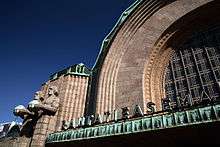
Being the national capital, all major train stations in Finland have direct services to Helsinki. All long-distance trains to the city terminate at the 🌍 Central Railway Station. which provides easy interchange to metro, bus, tram and local train lines. The train station offers bars, currency exchange, kiosks, fast food restaurants and many other amenities, in addition to a central location. All trains also stop at 🌍 Pasila station., some 4 km north, which might a good option if you're going elsewhere than central Helsinki. Due to a massive construction project going on in Pasila until 2020 (involving construction of a new railway station and several high-rises), a temporary railway station is in use and access to the station (walking paths, public transport stops) are subject to change.
International connections are limited to Saint Petersburg (4 daily trains) and Moscow (daily overnight train) in Russia. Moscow, in turn, is well connected to the CIS countries and even to the Far East along the Trans-Siberian.
By car
Expressways connect Helsinki to Turku to the west, Tampere and Lahti to the north, and to Porvoo and towards Saint Petersburg in the east. The south and west of Finland are mostly surrounded by water, but you can bring your car on ferries from Tallinn (south, many daily connections), Stockholm (west, daily), or even Germany (southwest). See "by boat" below. There are more ferry options from Sweden to the west coast of Finland.
By bus
Long-distance national and international buses terminate at the new underground 🌍 Central Bus Station (Linja-autoasema) in the basement of the Kamppi mall (Kampin Keskus). The station is adjacent to Mannerheimintie, directly connected to the Kamppi metro station and within a short walking distance from the Central Railway Station.
Low-cost bus operator Onnibus connects Helsinki to many major cities, including Tampere and Turku with prices starting from €3 (if booked in advance). Buses to Tampere leave from the small curbside stop in front of the Kiasma art museum and the ones to Turku depart from the Kamppi long-distance bus terminal.
For travel from St. Petersburg (Russia), Russian minibuses depart from the Oktyabrskaya Hotel (opp Moskovsky train station) around 22:00 and arrive behind Tennispalatsi at Eteläinen Rautatiekatu 8, one block away from Kamppi, early in the morning. Departures back start around 10:00 in the morning. The trip costs around €15, making this by far the cheapest option, but the buses are cramped and uncomfortable and some of them stop at numerous supermarkets on the way so that Russian passengers can go for tax-free shopping.
By boat
- See also: Baltic Sea ferries, Sailing in Finland

Helsinki is well connected with ferry services to Tallinn (Estonia) and Stockholm (Sweden), and there are limited services to Travemünde and Rostock, Germany. Scheduled service to St. Petersburg (Russia) operates, and there are occasional winter/summer cruises.
Ferries arrive at three harbours with six terminals:
- 🌍 West Harbour, Terminal 1 (Länsisatama, Terminaali 1), Hietasaarenkuja 8. The old terminal of the western harbour nowadays only serves St. Peter Line from St. Petersburg. The terminal has luggage lockers, café, a trolley rental, kiosk, a restaurant, public transport ticket machine, bank and an ATM. Accessed by trams 6T and 7, trams 8 and 9 are about 500 m away.
- 🌍 West Harbour, Terminal 2 (Länsisatama, Terminaali 2), Tyynenmerenkatu 14. Opened in early 2017 on reclaimed land south of the older Terminal 1, Tallink's and Eckerö Line's ferries from Tallinn dock here. Accessed by trams 6T and 7, trams 8 and 9 are about 500 m away.
- 🌍 South Harbour, Olympia Terminal (Eteläsatama, Olympiaterminaali), Olympiaranta 1. West shore of the bay. Tallink Silja's overnight cruise ferries to Stockholm M/S Silja Serenade and M/S Silja Symphony dock at Olympia Terminal. The terminal has a money exchange, an ATM, luggage lockers, a trolley rental, a restaurant, kiosk, and the Silja Line service point. The terminal was built for the 1952 Olympic Games, hence the name. Trams 2 and 3 stop almost right outside the terminal.
- 🌍 South Harbour, Katajanokka Terminal (Katajanokan terminaali), Katajanokanlaituri 8. East shore of the bay. Viking Line ships (M/S Gabriella, M/S Mariella, M/S Viking XPRS) arrive at Katajanokka Terminal. The terminal has a restaurant, kiosk, an ATM, a currency exchange, luggage lockers, and the Viking Line service point. The terminus of tram 5 (only operates around departures and arrivals of ferries) is in front of the terminal, while tram 4 stops a few blocks towards the city center.
- 🌍 Vuosaari Harbour, Hansa Terminal (Vuosaaren satama, Hansaterminaali), Provianttikatu 5. Mainly a cargo port, but used also by Finnlines services to Travemünde. Take metro to Vuosaari and continue by bus 90.
See the Port of Helsinki site for the latest details.
By ferry from Tallinn
The ferry route from Tallinn, Estonia to Helsinki has upwards of 20 departures daily. Depending on the ferry, journey time is anywhere from 1½ to 3½ hours. Prices average €16-30 one way, depending on operator, season (summer costs more), day of week (Fridays and Saturdays cost more) and time of day (out in the morning and back in the evening is popular and hence more expensive). Particularly popular are day cruises, which can go for as little as €15 return. All ferries also carry cars, from €25 one way. Bicycles can be taken for around €5 one way. Bikes on car ferries must go through vehicle check-in, which closes earlier than passenger check-in, so plan for extra time.
The following companies operate ferries between Tallinn and Helsinki:
- Eckerö Line, ☎ +372 664 6000, e-mail: info.ee@eckeroline.ee. Operates only one ship, the 2000-passenger Finlandia (three times daily, travel time 2½ hr). Often has the cheapest fares.
- Tallink Silja, ☎ +372 640 9808, e-mail: booking@tallink.ee. Up to 6 departures daily on large Shuttles Star and Superstar (2 hr). Discounts are available to Eurail pass holders. As this company has more departures you will have more flexibility planning your day trip.
- Viking Line. Large Viking XPRS ferry (2½ hr, 2 sailings a day). Most offers are aimed at travellers going in the opposite direction.
Eckerö and Viking usually have the cheaper fares, as they are more geared towards day-trippers and the party crowd who come to have a great time on board and tend to spend more in the bars, restaurants and shops on board. Their timetables are adjusted to day-trippers from Helsinki; in the other direction you may find them suitable only if you’re going one-way or spending more than just a day in Helsinki. Tallink and especially Linda Line are more geared towards frequent travellers such as Estonians working in Finland; their timetables give you plenty of time for a day trip from Tallinn.
Arriving by yacht
Beware of the very busy ferry traffic, especially the fast ferries from Tallinn. Use boating routes if possible. There are guest harbours in Katajanokka in central Helsinki; Pihlajasaari and Suomenlinna in the southern islands and Iso Vasikkasaari in Espoo. If you need customs clearance you should use the customs route from Helsinki lighthouse past Harmaja to the coast guard station at Katajanokka.
Get around
New fare zones and fares will be introduced on 27 April 2019.
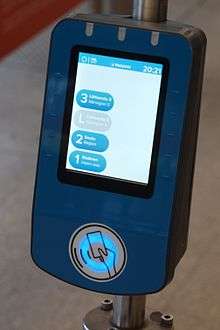
All public transport within Helsinki, Vantaa, Espoo and Kauniainen is coordinated by HSL. There are three zones in the HSL area, with four different ticket types available:
- 1 Internal ticket (sisäinen lippu) — valid for 60 minutes within a single city (for example, within Helsinki)
- 2 Regional ticket (seutulippu) — valid for 80 minutes within Helsinki, Vantaa, Espoo and Kauniainen
- L Regional two-zone (lähiseutu 2) — valid for 80 minutes within the whole region except Helsinki
- 3 Regional three-zone (lähiseutu 3) — valid for 100 minutes within the whole region
Additionally, a tram ticket (raitiovaunulippu) is available, valid for 60 minutes on trams only.
Tickets can be purchased from several different places. The price of the ticket depends on the method of purchase. The following fares are the most common:
- Tram ticket — €1.70 with a travel card, €2.50 from a ticket machine
- Internal ticket — €2.20 with mobile phone application or travel card, €2.90 from a ticket machine or R-Kioski, €3.20 from a bus driver
- Regional ticket — €4.20 with mobile phone application or travel card, €5.00 from a ticket machine or R-Kioski, €5.50 from a bus driver
All tickets are valid on all types of transport, and allow unlimited transfers within their validity periods and regions. Unlike public transportation tickets in many other cities the ticket is not invalidated if you exit the vehicle before the time has expired. Children under the age of seven travel free, while tickets for children under the age of 17 are half price. At night (00:00–05:00) the fares are higher; for some tickets you need to pay almost double.
Paper tickets cannot be bought on board trams, trains, metro or Suomenlinna ferry. The travel card readers are inside trams and trains, and before the platform areas for metro and Suomenlinna ferry.
The Travel Card (matkakortti) is an RFID card sold at R-kioskis and HSL offices, very similar to London's Oyster card. The Travel Card costs €5 (non-refundable) and gives a discount on fares. Hold the card on the reader without pressing anything to see the remaining value or to register a transfer. A travel card for non-residents can be bought at most R-kioski stores, and can be cost-effective if you are using many single tickets (including multiple people sharing the card), or are here for 14 days and can get the 14-day season ticket for non-residents instead of weekly day passes.
Alternatively, you can opt for the HSL Day Ticket or the Helsinki Card, both of which offer unlimited travel within the city.
- HSL Day Ticket (vuorokausilippu) — 1 day (= 24 hours) €9.00, 2 days (= 48 hours) €13.50, etc. Tickets are sold at HSL offices, R-Kioskis, ticket machines and bus drivers.
- Helsinki Card — 1 day €48 (children €23) to 3 days €68 (children €33) with a discount of €3 if purchased online. The Helsinki Card also offers free admission to a number of museums and other attractions.
The very useful HSL Journey Planner will get you from a street address, place or sight to another by suggesting possible public transport connections, covering the entire metropolitan Helsinki region. Try e.g. "Airport" or "Railway station" for place names. It is also available in several third party mobile apps for most smart phones, which can use GPS to find your current location.
The official HSL App offers a great and way to get your ticket, as well as an in-app journey planner to get you in your destination.
Getting around at night can be a bit tricky (or expensive), as most trains and trams stop before midnight and the buses before 02:00. A limited night bus network, all leaving from either Elielinaukio or Rautatientori next to the railway station, runs on weekends and public holidays after 02:00, at the same price as a normal ticket.
There are no ticket checks when getting on the metro, trains, trams or the Suomenlinna ferry, but ticket inspectors perform random checks on board. If you ride without a ticket and get caught by inspectors, you will be fined €80 plus the price of a ticket.
By tram
|
Beers on wheels The SpåraKOFF Bar Tram is a bright red tram converted into a pub on wheels. The tram runs during the summer only from Tuesday to Saturday, once an hour from 14:00 to 20:00 in a counterclockwise circle, with stops at the Linnanmäki amusement park, Opera House, and the Market Square. The tour lasts about 50 minutes. The price of €11 does not include any drinks. |
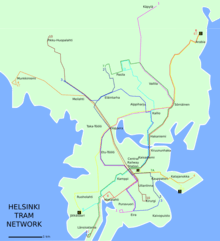
For tourists, the most convenient and scenic means of travel is the extensive tram network, though the last of the practical circular routes 7A and 7B were discontinued in August 2017. For an up-to-date route map and additional information check out HSL's website.
There is also a free Helsinki Sightseeing 3T Tram Audio Guide available for downloading here. It follows the route of now-discontinued tram 3T, that you will be able to replicate by taking trams 2 and 3, transferring at the Olympiaterminaali and in Taka-Töölö or on Nordensköldinkatu.
By bus
While the trams operate in the city center, buses cover the rest of the city. The main stations for northbound and eastbound buses are on the two squares adjacent to the Central Railway Station: Eliel Square (Elielinaukio) and Railway Square (Rautatientori). Westbound buses operate from the underground bus station in the Kamppi Center which is adjacent to the Kamppi metro station.
Buses are always entered through the front door and exited through the middle and back doors. When getting on the bus with a ticket you have bought earlier, you need to show it to the driver. If you don't have a ticket, you can buy one from the driver in cash (but don't try to use a bill larger than €20, as the drivers may sometimes refuse your money if they have only a limited amount of change). If you are using a travel card, follow the instructions given above.
By metro
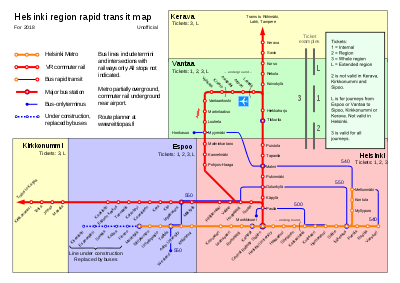
Helsinki's metro holds the minor distinction of being the northernmost subway system in the world with Mellunmäki being the northernmost station. The distinct orange metro cars are worth a ride.
With the western extension opening in November 2017, there are now two lines, but for the most part they run next to each other so they can be considered one single line. Both start in Espoo, M1 in Matinkylä and M2 in Tapiola three stations along the line, proceeding through central Helsinki to the eastern suburbs. At Itäkeskus M1 forks south to Vuosaari and M2 north to Mellunmäki.
By train
VR's suburban trains operate north from the Central Railway Station, branching out in three directions. HSL city tickets are valid within city limits, regional tickets on suburban trains to Espoo, Vantaa and Kauniainen.
All carriages on local trains have the electronic readers which allow you to buy a fare with a travel card. Ticket sales on board trains on the HSL network have been discontinued, and you have to buy a ticket before you board the train. Some stations have ticket vending machines, or you can buy a ticket with your phone, from R-kioski kiosks, or HSL service points.
By ferry
The HSL ferry to Suomenlinna from the Market Square (Kauppatori) is a cheap and popular summer getaway. Another HSL operated ferry, mostly used only by the island's residents, leaves from the eastern end of Katajanokka. In addition, private operators provide ferries to Suomenlinna and various other islands during the summer; however, schedules can be sparse. HSL's Day Ticket and mobile-phone ticket are both valid also on the Suomenlinna ferry.
By taxi
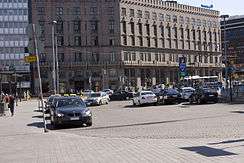
Taxis in Finland are expensive. Taxi fares were regulated by the government until July 2018 and in most of the country prices and practices have stayed about the same, but in the Helsinki region there is competition and the prices have risen with some 14%. Taxis are now free to set the prices as they like, but the prices have to be available or told, and you have to be warned if the price may turn out to be more than €100.
Comparing prices is not straight forward, as some companies have higher flag-fall price, some count both time and distance, and a few do not use taximeters at all, but offer fixed prices. The biggest players are Taxi Helsinki and Lähitaksi.
During weekend nights and some popular events or holidays, it can be difficult to find a free taxi. Walk to the nearest taxi stand or try to book one by phone from Taxi Helsinki 0100-0700 or Lähitaksi 0100-7300 (€2+1.5/min). If it's a very busy night, try calling Taksione at +358 50-545-5454 or Kajon at 0100-7070. To pre-order a taxi for a given time, call 0100-0600 (€2.76/call+0.35/min) for Taxi Helsinki, the normal number for the others. A pre-order for a taxi should be made at least half an hour, preferably a day or two, beforehand. A pre-order fee of €7–14 will be added to the taxi fare.
Drivers are not required to pick up a person hailing them on the street. If their light is on, and they pass a person hailing them, it is usually because there is a taxi stand very near by with available taxis waiting for customers. If you are not near a taxi stand, you will very likely be able to hail a passing taxi with the light on. If the queues at night seem frustratingly long in the city centre and you are willing to walk a bit, try heading towards Hakaniementori or Lauttasaari Bridge, where you can often hail a returning taxi (however, do not bother if the light is not on).
Some taxis are equipped with baby seats or other special equipment, ask when booking if you need them. Baby seats are not legally required for temporary car use, such as taxis.
Helsinki Limo will provide airport pick-ups, private car services as transfers and longer trips. Their vehicles are always new and black with leather interior. Worth of asking offers either from or simply calling +358 20-787-0360. Drivers speak English and can even, by order, give short sightseeings.
Also Yellow Line offers transport from the airport. They have minivans, which carry up to seven or eight passengers and drop passengers off at their individual destinations. The shuttles can be found at their bright yellow desks in arrivals lounges 1 and 2. Prices start from €27 for one or two passengers and vary according to the number of people in the van.
By bike
Helsinki's City Bike bike-sharing system was relaunched in 2017. The system offers 1400 bikes spread across 140 stations. Users may buy passes good for one day (€5), one week (€10), or the full season (€25), which provide access to the bikes. Use of a bike for up to 30 minutes is free, with increasing charges for longer rides. (Avoid these charges by returning the bike to a station within the 30-minute window – and checking it out again if you wish.)
Several businesses also offer bicycle rentals.
If you bring your own bike, use City Bikes, or rent a bike, you'll find an extensive network of bike routes within the city. Bikers are required by law to ride on the street next to cars unless a bike lane or integrated pedestrian/cyclists sidewalk runs next to it, and the police ticket cyclists breaking this rule. Bike lanes are clearly marked by street markings and blue traffic signs. Biking is also allowed on pedestrian streets.
Downtown bike lanes are typically on the sidewalks (instead of next to car lanes on the street) so be aware of pedestrians. Don't be afraid to ring your bell! Review your bike map carefully, as some bike routes will stop and require you to walk your bike or drive next to cars. There is also a journey planner for cycling. Once you get out of the city centre, cycling is less complicated and there are great, well-labelled paths.
Public libraries often have free biking maps for the Helsinki Metropolitan Area. If they are not visibly displayed on tables, ask for one from the staff.
If an ordinary bike isn't enough for you, you can also rent a cyclerickshaw (riksa) large enough for three from Riksavuokraus (tel. +358 50-5582525) in Eiranranta near Kaivopuisto. Prices start at €9/30 min, driver not included but available on request.
Baana

Baana – Helsinki's new "Low Line" (as opposed to NYC's High Line) opened on June 12, 2012, providing pedestrians and cyclists with a 1.3 km long connector from the Western Harbour area to Kamppi and Töölö Bay. At the Harbour end, you can see all the international cruise ships that stop in Helsinki and visit a free sightseeing terrace with MiG-21BIS fighter jet on display, at the Verkkokauppa.com electronics store. On the Kamppi end, there's bicycle hire centre and cultural activities and sights.
By foot
Don't forget walking! The central part of Helsinki is compact and easily walkable. There is no need for public transportation in the main Kamppi–Central railway station area where many attractions are, and even anywhere on the main peninsula (south of the train station) is within 30 minutes at a nice leisurely pace.
By car
Car is not a particularly good way of getting around central Helsinki. If you have your own, consider not using it more than necessary. If you are going to rent a car, consider postponing it until you are going to leave the town.
Central Helsinki is rather difficult to get around by car due to restrictions (one-way streets etc.), and is congested in the morning 06:30–08:30 towards the city and in the afternoon 15:00–17:00 towards the suburbs – the ring roads are congested both directions at both times. For instance, if driving from Porvoo to central Helsinki at around 16:00, one can expect to spend half an hour driving 47 km to the end of the motorway and another half an hour to drive 7 km to the Kamppi centre.
Also parking is limited and expensive. Most street-side parking in the city centre is in "Zone 1" and costs €4/hour during working hours, although Saturdays (mostly) and Sundays (always) are free. There are also several large underground car parks at the Kamppi and Forum shopping centres.
See
- See #Districts for listings.
Surrounded by sea and a vast archipelago, Helsinki is at its best in the summer when the dialogue between the city and nature is at its fullest. Classical Helsinki's sights can be divided into an eclectic set of churches and a wide variety of museums. For a coastal amble past some of Helsinki's minor and major sights, see the itinerary A seaside stroll in Helsinki.
Museums and galleries
Many of Helsinki's museums are as interesting from the outside as from the inside. Architecture buffs will get a kick out of Helsinki's Neo-Classical center, centered around Senate Square (Senaatintori), where a statue of the liberal Russian czar Alexander II stands guard. Aleksanterinkatu and the Railway Station square also have some beautiful neo-classical buildings — look for the Romantic Kalevala-esque themes — but unfortunately these areas also have many concrete monstrosities mixed in.
Islands
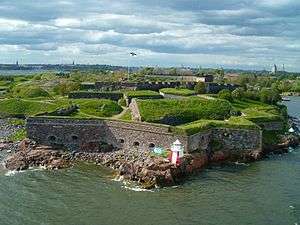
If you see only one place in Helsinki in the summer, make it Suomenlinna. Entry to the island itself is free, but you need to pay for the ferry ride. The HSL ferry from Market Square is the cheapest and most convenient way of getting there at €5 for a 12-hour tourist return. The ferry is a part of the Helsinki local traffic, so if you have an HSL Day Ticket it includes ferry travel. The ferry runs approximately every half hour. On summer weekends the island is a popular picnic destination and you may have to wait for a long time as hundreds of people crowd the ferry terminal. In this case it may be worth it to use the more expensive private ferry company at the other end of the Market Square.
Suomenlinna is far from the only island, a beautiful archipelago (saaristo) surrounds the Helsinki city center. The major islands are Korkeasaari with the eponymous zoo, Seurasaari with its open air museum and Pihjalasaari with its beach. In addition to these, there are scheduled services to many smaller islands, and you can also tour them by sightseeing cruise. Most of the cruises depart from the Western corner of the Market Square and last from one to several hours. Most ferries and cruises operate only in the summer high season.
Do
- See #Districts for listings.
Cinema
The situation with movie theaters in Helsinki has deteriorated as one by one small theaters have closed their doors.
Foreign films are mostly shown in the original language with Finnish (and usually Swedish) subtitles.
In downtown Helsinki, there are two large multiplexes: Tennispalatsi in Salomonkatu 15, Kamppi and Kinopalatsi in Kaisaniemenkatu 2, Kaisaniemi, both maintained by Finnkino, the largest movie theater chain in Finland. Prices vary between €6.50 and €17.50 depending on location, time and 2D/3D. See Finnkino's pricing policy on their website.
Theaters concentrating on classic and art house films are few and far between in Helsinki today. The movie theater Orion, Eerikinkatu 15, run by the Finnish National Audiovisual Archive, displays a wide variety of films, including classics. Tickets €6.00 for non-members and €4.50 with a membership card. Kino Engel, Sofiankatu 4 near Senaatintori, concentrates on European and world cinema. Tickets €9. In Summers, also Kesäkino (Summer Cinema) is held in the inner court of Café Engel, Aleksanterinkatu 26. Tickets (€12) can be bought from the Kino Engel counter and for the same night also from the Kesäkino door 45 minutes before the screening.
There are also some (small) independent movie theaters in neighboring Espoo, Vantaa and Kauniainen showing mainly the bigger blockbusters: Bio Grand in Tikkurila, Vantaa, Bio Jaseka in Myyrmäki, Vantaa, Bio Grani in Kauniainen and Kino Tapiola in Tapiola, Espoo. Many of them have a matinée series of cheaper, more art house screenings supported by the local culture board. In addition, Finnkino operates three screens in Omena cinema in the Iso Omena shopping center in Matinkylä, Espoo as well as six screens in Flamingo multiplex in the entertainment center Flamingo in Vantaa. In Leppävaara, Espoo there are also six screens in the Finnkino multiplex at Sello shopping center.
Luckily, several film festivals enrich the cinema culture in Helsinki region. The biggest is the Helsinki International Film Festival - Love and Anarchy held annually in September. Espoo has its own international film festival Espoo Ciné held every August in Tapiola and Leppävaara. In January, Helsinki Documentary Film Festival Docpoint takes over. Some of the smaller film festivals include (to name few) Lens Politica showing political films and art, and Night Visions focusing on horror, fantasy, science fiction, action and cult cinema. Cinemania website collects at least some of the festivals together and also sells passes of 5 or 10 screenings that may be used in several festivals. However, check the site for the most up-to-date information as the ticket policy varies from festival to festival.
Concerts
Helsinki has an active cultural life and tickets are generally inexpensive.
- tiketti. There are many lives of many genres. So you must browse what show will be held and buy ticket.
- tavastia. Live club with live rock, pop and jazz.
Important performing groups include:
- Helsinki Philharmonic Orchestra (Kaupunginorkesteri). Performances have moved to the Music House, a brand new visually questionable but acustically excellent concert hall. Tickets €20. On selected Wednesdays you can go see dress rehearsals for as little as €3 per person. The rehearsals start 09:30. Check availability on the site before showing up at the Music House!
- UMO Jazz Orchestra. An important part of Finnish jazz life, known for performing new Finnish music alongside interesting shows, such as with new circus. Various venues.
Events
Helsinki's celebrations are among the most exciting in the country.
January

- Lux Helsinki. 17:00-22:00. Beginning of January. Lux Helsinki is an annual event of light installations to cheer residents' and visitors' minds during the darkest time of the year. They are on display over several nights. Lux Helsinki can also be enjoyed as part of a guided walking tour. Free of charge.
February

- 🌍 Helsinki Burlesque Festival, Pikku Roobertinkatu 12, ☎ +358 40-744-5999, e-mail: tassel@helsinkiburlesque.com. 19:00-04:00. Finland's biggest burlesque show. Held on a weekend in late February/early March. Although most of the performers are female, the Finnish burlesque scene has more male performers than that of any other country. Many visitors come in fancy dress costumes, and there is even a prize awarded for the best dressed man and the best dressed woman in the audience. For adults only. €83 for a two-day pass.
April
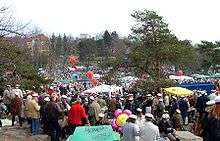
- Vappu (Walpurgis Night). April 30-May 1. Vappu began as a north European pagan carnival, and is now an excuse for students to wear brightly colored overalls and for everybody to drink vast amounts of alcohol. At 18:00 on April 30, the statue of Havis Amanda at the Market Square is crowned with a student's cap and the revelry begins in the streets. Things can get a little ugly outside as the night wears on, so it's wiser to head indoors to the bars, clubs and restaurants, all of which have massive Vappu parties. The following morning, the party heads to the Kaivopuisto and Kaisaniemi parks for a champagne picnic, regardless of the weather. If the weather is good, up to 70,000 people will show up. Left-wing parties hold rallies and speeches, but the event is increasingly non-political.
May
- World Village Festival (in Finnish Maailma Kylässä). An annual multicultural weekend festival in late May. The event is free to all and a meeting place offering tastes of different cultures and surprises from all over the world, music, dance, food, art, market, information. Several hundred organizations are involved and the main organiser KEPA works under the Ministry for Foreign Affairs of Finland.
- Helsinki City Run. A running event in central Helsinki where you can run the length of a half-marathon.
June
- Helsinki-päivä (Helsinki Day). Jun 12. This is the birthday of the city. It traditionally starts with the mayor's morning coffee and is celebrated throughout the day with a variety of concerts, performances, exhibitions and guided tours around the city. Nowadays special event program even for several days.
- 🌍 Helsinki Pride. Parade 13:00-14:00, party 14:00-18:00. Finland's biggest and most famous LGBT pride event. Held over a week in late June, culminates in a parade and open-air party on Saturday. Free of charge.

- 🌍 . 15:00-17:00. The biggest samba show in Finland, inspired by the famous Rio de Janeiro Carnaval in Brazil. Held on a Saturday in early June. A great samba parade fills the streets of central Helsinki, with dancers and music players from practically every samba school in Finland. Free of charge.
- Juhannus (Midsummer Festival). Friday between June 19 and June 25. Although a large bonfire is lit in Seurasaari, the celebration is low key as the tradition is to celebrate "the nightless night" at summer cottages in the countryside. Although some celebrate Juhannus in Helsinki as well, the streets are often eerily empty and the doors of the shops closed, making it the most quiet time of year in Helsinki.
July
- Visio Festival: 20–21 July 2018. New electronic music festival (date needs updating)
- Teurastamo Jazz: 14–14 July 2018. A jazz happening in the Teurastamo area in Helsinki. (date needs updating)
- Hori Smoku Summer Bugaloo: 27–28 July 2018. Punk and alternative rock festival in Ääniwalli, Helsinki (date needs updating)
- Jazz-Espa: 29 July – 5 August 2018. A jazz happening on Espa stage with free outdoors concerts. The organizer Finnish Jazz Federation is celebrating its 50th birthday and to celebrate the program includes jazz big bands. (date needs updating)
- Tuska Open Air. An annual, 3-day heavy metal festival, featuring acts from all over the world, held in July.
August
- Weekend Festival (WKND): 17–19 August 2018. Techno and dance oriented festival (date needs updating)
- Helsinki City Marathon. Next event: May 18, 2019. The name says it all. Not as famous as the one in New York, but with over 6,000 participants the largest marathon race in Finland.
- Flow Festival. A music and arts festival in early August at Suvilahti. Noted for its high-end arrangements marrying music to design and gourmet food and drink, Flow has expanded to include installations, arts and workshops in the past few years. The music presented at Flow is a strong and varied selection of up and coming and established artists from indie-rock to soul and jazz and from folk to contemporary club sounds, both from the Finnish and the international scene.
- Finland-Sweden athletics competition. biannually held in Finland. A yearly athletics international competition held between these two neighboring countries since 1925 – the only one still existing of this kind of two-country competition. The two-day event, held in alternate years in Finland or in Sweden, attracts significant audiences.
- Helsinki Festival (Helsingin Juhlaviikot). Multi-week annual arts festival in the latter half of August. The peak of the festival is Taiteiden Yö, "Night of the Arts" called "little vappu" by many as the streets are full of revelers. The official event is marked by performing arts through the night. The Night of the Arts was first organized by local bookstores in the 1990s. It's now organized by the city. During the last few years, the event has slightly returned to its origin as an arts and culture event.
- We Love The 90's: 27–28 August 2018. A music festival focusing on 1990s music in the Suvilahti concert area. (date needs updating)
September
- Helsinki International Film Festival. Also known as Rakkautta & Anarkiaa (Love & Anarchy) and held annually in September, HIFF features a wide selection of films from all over the world. Asian films have been a special focus in the history of the festival that began in 1987.
November
- 🌍 Lautapelaamaan, Tallberginkatu 1. 10:00-18:00 mostly. Finland's biggest board game event, hosted by the Finnish Board Game Society. Held on a weeked in early November. A whole hall at the Helsinki Cable Factory is available to play board games for the entire weekend, from Friday evening to Sunday evening (the event closes for the nights though). Hundreds of board games available provided by the organisers (to borrow a game to play, you must leave something valuable as a pawn token, such as your phone or wallet). You can also bring your own board games to play. Suitable for people of all ages, both adults and children. Free of charge.
- 🌍 Liquorice and salmiak festival, Pikku Satamakatu 3-5. 11:00-17:00 mostly. Finns are known for their taste for liquorice flavoured with the salt ammonium chloride, popularly known as salmiak or salmiakki in Finnish, even if many foreigners may find the taste strange and even repulsive at first. Wanha Satama in Katajanokka holds an entire festival for salty liquorice candy on a weekend in middle November. More liquorice candy than you can shake a stick at, with salmiak and without. Several vendors offer their candy for sale and give you free samples. €12.
December
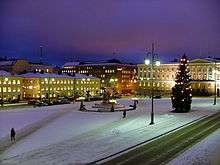
- Slush. 2018: 4–5 December. Big happening where startup companies meet possible investors from all over the world, arranged mostly by volunteer students. Expect hotels to be sold out, and paying a premium if booking early.
- Joulu (Christmas). In the weeks before Christmas, Aleksanterinkatu is festively lit up, the Christmas lights of the street are ceremonially lit on the last Sunday in November. The open-air Christmas market formerly held in the Esplanadi Park is nowadays held at the Senaatintori (Senate Square). The Stockmann department store sets up a Christmas themed exhibition with mechanic dolls and animals in their windows at the corner of Keskuskatu and Aleksanterinkatu. Christmas itself is a family event, so on the 24th, everything shuts down and stays closed until December 26.
- New Year's Eve. Dec 31-Jan 1. Like in many other major cities, thousands of Helsinkians gather at Senaatintori next to the Cathedral to welcome the New Year. The event is shown on live television and there is a free outdoor concert as well.
At sea
Helsinki is on the Finnish Gulf, and several cruise liners arrange trips out to the archipelago ranging from short hops lasting only an hour or two to trips ranging a full day.
- Söderskär Lighthouse (Royal Line from Kauppatori market), ☎ +358 400-502-771, e-mail: majakka@soderskar.fi. July-midAig: Tu The Sa at 11:00. An old secluded lighthouse island out at sea, in the middle of a bird reserve. Day trips are arranged by Royal Line, including lunch, a guided tour of the lighthouse (Finnish/English) and a couple of hours to linger on the island, but it is also possible to stay the night. Day cruise €52/25, hostel starting at €40/person.
- Skippered Day Sailing, Laivastokatu 1, Katajanokka, ☎ +358 50-592-9141, e-mail: toimisto@tulepurjehtimaan.com. leaves daily 10:00. Visit the coastal archipelago on a 35 ft sailboat, for two hours or full day trips with an experienced skipper. Island hopping is also possible. from €60.
Learn
Most of Finland's exchange students end up in Helsinki's universities.
- University of Helsinki (Helsingin Yliopisto). With over 40,000 students, this is Finland's largest university and its alumni include Linus Torvalds, the creator of the Linux kernel.
- Aalto University (Aalto-yliopisto). Formed from three leading universities in their respective areas: Helsinki University of Technology (Teknillinen korkeakoulu) — Considered "Finland's MIT", this university is in Otaniemi, Espoo, just across the municipality border, University of Art and Design Helsinki (Taideteollinen korkeakoulu)—The biggest art university in Scandinavia with the highest rate of exchange students of all Finnish universities and Helsinki School of Economics (Helsingin kauppakorkeakoulu) — The country's largest institution for university level business education. The Aalto University was named after architect and designer Alvar Aalto.
- Hanken, Swedish School of Economics and Business Administration.
- Sibelius Academy. The only music university in Finland and one of the largest in Europe.
As the Alexander University i.e. University of Helsinki was a legal deposit repository also during the Russian time, Helsinki has the largest collection of Russian printed material from the 19th century outside Russia. For many people studying it here is far easier than the alternative.
Finnish
The University of Helsinki offers a highly popular Finnish for Foreigners program in six different skill levels, ranging from absolute beginner to advanced courses ending with language certification. Spring and Fall classes are offered in standard 1 unit (3 hr/wk, €135) and intensive 2 unit (8 hr/wk, €310) versions.
Summer courses on Finnish language and culture are available at the major universities including Helsinki.
Work
As elsewhere in the country, obtaining work in Helsinki may be difficult. See the main Finland article for details.
Buy
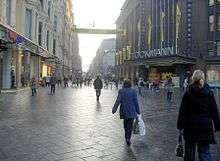
- See #Districts for listings.
Shopping in Helsinki is generally not so expensive, fans of Finnish and Nordic design will find plenty of things of interest. You can also enjoy the season of sales and discounts (in January and July). Since 2016, opening hours have been fully liberalized, but most large shops and department stores still have the normal hours of weekdays from 09:00-21:00, Saturdys 09:00-18:00, and Sunday 12:00-18:00. A notable exception is the Asematunneli complex, underground adjacent to the Central Railway Station, most shops here are open until 22:00 almost every day of the year. Hours are still in a state of flux and for the most part you could expect them to get longer.
All S-markets are open until 22:00 every day. At least the major supermarkets K-Supermarket and Lidl in the Kamppi Center (see below) are open until 22:00 each day, and the S-Market supermarket below Sokos, next to the railway station, is open 24/7. Small grocery stores and the R-Kioski convenience store chain are open until 22:00 or 23:00 (or later) year-round, too. A handful of small Alepa grocery stores are open 24 hours a day. In the centre you will also find small Delish and Pick A Deli convenience stores in the city center, open 24 hours a day year round but more expensive than regular grocery stores. On holidays, many stores are closed (though we need to see how this changes with the new opening hour laws), but at least the central S-supermarket (Sokos) and K-supermarket (Kamppi) are historically barely affected by holidays. Other centrally located small grocery stores and R-kioskis have some holiday opening hours, too.
In the neighboring cities of Vantaa and Espoo you can also find big shopping malls. Vantaa has Jumbo(including Flamingo) and Myyrmanni, while Espoo has the centers of Sello and Iso Omena. All of these are easily accessible by public transport or by car (free parking).
Design
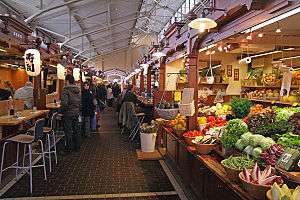
There are high-end design stores around Aleksanterinkatu and Etelä-Esplanadi. The Design District Helsinki area around Uudenmaankatu and Iso Roobertinkatu is full of design and antique shops, fashion stores, museums, art galleries, restaurants and showrooms. Here you can find the most interesting names, classics, and trend-setters. Visit Design Forum Finland at Erottajankatu 7 to get a map of shops and galleries.
Markets
Most outdoor markets in Helsinki are open only in summer, but the market halls are open all year round. They are great places to taste Finnish delicacies. The three major market halls are the Old Market Hall, Hietaniemi and Hakaniemi.
Records
Helsinki has a selection of great "underground" record stores with a greatly varying selection of both Finnish and international music. Most of them also sell vinyl (12, 10 or 7 inch). Generally speaking, prices aren't cheap, but the selection may be worth it. Some of the more collectible stuff may even be cheaper than elsewhere. Price range is vinyl €20 ±€5 and CD €10 ±€5.
If you have only a limited amount of time, check out the record stores around Viisikulma, a brisk walk from the city center.
Clothing
In addition to Aleksanterinkatu, various fashion boutiques can be found along Fredrikinkatu, a 10-15 minute walk south from the railway station. Of course you can also head to department stores and malls like Stockmann, Kamppi and Forum.
Eat
- See #Districts for listings.
| This page uses the following price ranges for a typical meal for one, including soft drink: | |
| Budget | Under €10 |
| Mid-range | €10–30 |
| Splurge | Over €30 |
Helsinki has by far the best cosmopolitan restaurants in Finland, and is a good place to escape the usual diet of meat and potatoes... if you can foot the bill, that is. As usual in Finland the best time to eat out is lunch, when most restaurants offer lunch sets for around €6-10. Lunch sets are typically served from 10:30 to 14:00, but the times vary between venues. In the evening, only budget places are less than €10, while splurges cost well over €30 per head. Almost every place will have at least one vegetarian option.
A surprisingly large number of restaurants close down for a month or more in summer (July–August), so call ahead to avoid disappointment.
Budget choices are largely limited to fast food, although there are a couple of workaday Finnish eateries in the mix. In addition to McDonald's and its Finnish imitators Hesburger/Carrols, Helsinki is also full of pizza and kebab places, where a meal typically costs around €7-8 (sometimes as low as €4-5, especially in Kallio). A more healthy option is Unicafe, a chain of restaurants owned by the Helsinki University student union, which has around 10 outlets in central Helsinki and offers full meals from €5.70, including vegetarian options. There are also many other lunch restaurants for students that serve affordable food also for non-students. A good active listing of Helsinki's student restaurants and their menus as well as opening hours can be found at lunchmenu.fi. During the lunch time, usually from 11:00 to 15:00, most restaurants serves food for reasonable prices. Lunch restaurants and lists in Helsinki can be found at lounaat.info.
Two classes of fine dining stand out in Helsinki: fresh seafood and Russian. During the dark days of the Soviet Union, it was sometimes said that the best Russian restaurants in the world were across the border in Helsinki. For something authentically Finnish and uniquely Helsinki, try Vorschmack, an unusual but surprisingly tasty mix of minced lamb and herring, served with chopped pickles and sour cream (smetana).
Cafés
Finland is the largest coffee consuming nation per capita and coffee breaks are written into law. However, in Finland most coffee is filter-brewed from a light, more caffeinated, roast that is quite different to what the rest of the world drinks. Finns often enjoy a bun (pulla) or cinnamon bun (korvapuusti) with their coffee.
In Finland commonly espressos and lattes are called "special coffees" and a large number of establishments that make such coffees have popped up all over town ever since the 1990s when they arrived. One which will give any Italian cafeteria a go for their money is La Torrefazione next to Stockmann. In the more common cafeterias the normal light brew coffee is sold by self-service at the counter even at some more expensive cafeterias (there is only a handful of cafeterias serving to the table in Helsinki - this shows how commonplace coffee drinking is considered).
Drink
- See #Districts for listings.
Bars and pubs
Helsinki has plenty of hip places for a drink. The main nightlife districts, all in the city center within crawling distance of each other, are around Iso-Roobertinkatu, the Central Railway Station and Kamppi. Helsinki's busy gay nightlife is centered mostly around Iso-Roobertinkatu and Eerikinkatu and surrounding streets.
Going out is not cheap, and complaining about the prices is a popular Finnish pastime, but compared to (say) London or New York City the prices aren't that bad. If you are on a budget and intent on getting plastered, follow the Finns and drink up a good "base" at home or hotel before going out on town. Alternatively, you can start the night outside the city centre area and head to the district of Kallio where bar prices are significantly lower and you can find a plethora of drinking places.
While entry to bars and clubs is often (but not always) free, in club-type places and proper restaurants you must use and pay for the coat check (narikka), usually around €2, if you're wearing anything more than a T-shirt. In some places you must pay even if you don't leave anything at the cloakroom. The bouncer will be very strict with this as the much of the narikka-money goes into his pocket. If a ticket price is advertised, it usually does not cover the coat check.
The drinking age is 18, and this is rather strictly enforced, so bring along ID. Underaged drinking is still a huge problem, and many bars and clubs apply house limits of 20–24 years, but these are enforced less strictly and a patron of younger age will some times be let in if one fits the clientele, especially women.
Information on clubs and live performances can be found in free, Finnish-language tabloids such as City, which can be picked up at many bars, cafes and shops.
Nightclubs
In Helsinki, the most popular nightclubs have long queues starting to form around 23:30. Get in early to avoid standing, although it can be a nice way to meet people. After around 01:00-02:00 it might be impossible to get in anymore. You may try to just walk past the queue looking important, but a more efficient strategy is to discreetly tip the bouncer (€10-20). The larger group you are, the more difficult things get. Look smart!
Sleep
- See #Districts for listings.
Accommodation is generally quite expensive, but of a high standard. Hotels are usually cheaper on weekends, when business travellers are away.
Budget
There are quite a few budget hotels in Helsinki, the cheapest being youth hostels. Many student dormitories turn into youth hostels during the July–August school break, which happily coincides with peak season for tourists. The Finnish Youth Hostel Association can provide further information.
In a real pinch, the (by far) cheapest option can actually be to book a "last-minute" or "red-ticket" return cabin (from around €20) on an overnight cruise to Tallinn, and spend the night (and part of the next day) on the boat, rather than sleep in the city.
Mid-range
Hotels of national and international chains usually fall in this segment. Prices are usually above €100 per night. In addition, many apartments are rented for about €90–100 per night.
Splurge
The upscale hotels are in the city centre and in the western parts of the city. Hotel Kämp right at the Esplanade park is definitely the most luxurious choice, and usually the place where actors, pop stars and other celebrities stay when they come to Helsinki.
Stay safe
|
Risks in Helsinki
|
Helsinki is a safe city for its size. However, on weekend nights, intoxicated people wandering around city streets may be an annoyance, especially during summer festivals and on New Year's Eve and April 30, the eve of May Day, which is the most important beer-drinking festival in the Finnish calendar. Warm summer nights always gather a drunken crowd downtown. Intoxicated Finns tend to be rather noisy (in stark contrast to sober Finns) and admittedly sometimes picking a fight with just about anyone. Just use your common sense, and steer clear of overly loud groups of young men.
There are rare exceptional health hazards, although the extreme cold in the winter should be borne in mind by visitors, especially those planning outdoor activities. Whilst in summer the temperature rises occasionally to 30°C, in the winter months it can drop to around -30°C (-20°F) for a week or two. Dressing warmly is a must. If you forget to bring winter clothing, you can always visit local shops for appropriate apparel. Also, watch out for slippery sidewalks in winter. Thousands of people slip and injure themselves every winter! Winter-time driving needs also special caution as the roads may be very slippery with ice and/or snow.
- 🌍 Yliopiston Apteekki pharmacy, Mannerheimintie 96 (Taka-Töölö district), ☎ +358 300 20200. Open always 24/7. The pharmacy with the most central location and the best hours.
- 🌍 Haartman hospital emergency, Haartmaninkatu 4 (Meilahti hospital area), ☎ +358 9 310 63231. 24/7. Emergency department of Helsinki Municipal Health Center.
- 🌍 Viiskulma Health Centre, Pursimiehenkatu 4 (near Viiskulma), ☎ +358 9 310 45930, fax: +358 9 3104 5333. Weekdays 8-16. Municipal health center for minor health problems.
In emergencies, phone 112 (free from all phones).
Emergency Social Services
You can contact the social service, when you need urgent help or advice for:
- child protection
- other social work
- family crises
- domestic violence
- life management or housing
- matters related to mental health or substance abuse.
Emergency Social Services are available around the clock (24 hr): call +358 9 3104 4222. Emergency Social Services can also be contacted by calling the emergency number 112.
Crime
The crime rate in Helsinki is generally low – Helsinki being maybe one of the safest capitals in Europe – although locals grumble that things have gotten worse since the EU removed restrictions on movement. Pickpockets target crowds and bicycles are prone to petty theft. Walking in the streets after dark is generally safe and the city center is indeed quite lively until the early hours of the morning. However, it's best to steer clear of obviously drunk people looking to pick a fight, the traditional trouble spots being the frustratingly long queues for late night snack food or taxis. Getting mugged for money in the streets of central Helsinki is almost unheard of, but you might not want to get into any unlicensed taxis even though the licensed ones are almost always way short of demand during pre-Christmas and summer seasons. A licensed taxi in Finland will always have a yellow box with its number on the roof.
The most crimes in city center concentrate around the central railway station and Kamppi shopping center. The Kaisaniemi park behind the main Railway Station is possibly best avoided at night, and the area of Kalasatama, Kallio and Sörnäinen (northeast from the center, after the Pitkäsilta bridge) may be somewhat rougher than other parts of the downtown. Relatively high-crime neighborhoods are found in the 1970s concrete-built suburbs of Eastern Helsinki, Northwestern Helsinki and Northern Helsinki, mainly in the extreme reaches of the metro and local train, such as Kontula, Itäkeskus, Mellunmäki, Vuosaari along metro; Pukinmäki, Malmi, Puistola and Kannelmäki along local train.
Especially in the summer you will encounter Roma beggars from Eastern Europe sitting on the streets in the city center. Most locals would prefer it if you do not encourage them by giving money, and donate to a charity instead.
Pedestrian safety
In winter, try to keep a steady footing: despite the use of vast quantities of gravel and salt, pavements can be quite slippery when the temperature hovers around zero and near-invisible black ice forms.
Excavations
Helsinki's bedrock is close to the surface, so new building works invariably involve some dynamite to build foundations, and it's thus quite common to hear explosions around the center. Blasting is often preceded by a loud sequence of warning beeps, which speed up as they count down. There is no danger to anyone, as the builders are experts (and the solid granite bedrock is very, very strong), but now you know where that "BOOM!" came from.
Visa agencies
If you are just passing through and choose Helsinki to apply for a Russian visa, be careful when choosing a travel agency: some may charge a lot extra for "express service" (although applying for one yourself at the consulate will take weeks).
Respect
- When using escalators, people in Helsinki usually reserve the right side of the moving staircase for standing and the left side for people walking up the stairs. Standing still on the left side will certainly make people irritated and flag you as a tourist or a fool.
- It would be wise to use common sense when entering the metro car: do not block people when the doors open, but take one step back and let people get off first. Also, it is often customary to enter a tram from the right side of the doors while people exiting use their right side.
- Avoid walking in the cycle lane. Dedicated cycle paths are clearly marked, but sometimes run directly next to the sidewalk. Helsinki cyclists are subject to a comparatively hilly landscape and are unwilling to slow down and lose momentum. However, they are usually careful, signal clearly and use their bells, meaning that straying tourists most often are just sworn at.
- When waiting in lines, be patient and polite. Finns rarely cross queues but make sure you actually stand in the line. If you are not sure whether there is a queue, ask others.
- Finns usually do not address people who are doing things (in their opinion) wrong. They will just look at your foolish behavior and swear silently to themselves. You might embarrass yourself but addressing it will make an even bigger scene.
- Do not feed seagulls or pigeons (especially in the city center). Seagulls taking people's ice creams or sandwiches is a real problem in some areas, and feeding them is encouraging that behaviour. Feeding birds is also officially prohibited in many areas.
Connect
Internet access
Much of Helsinki is blanketed with wifi ("wlan") hotspots, and the City of Helsinki maintains a handy map. By comparison, Internet cafes with shared PCs are few and far between in Helsinki, but here is a partial listing. Most cafes offer these services without requiring a person to be a paying customer. Some restaurants will do this as well, but may insist that you purchase something. Many internet/cyber cafes in Finland can be expensive.
- Library 10, Elielinaukio 2G, ☎ +358 9 3108 5000. A public Internet and music library in the main post office building at the western side of the central railway station. You can surf the Internet for free for 30 minutes on the library's computers, but you're going to have to queue. Also has wi-fi, but you need a library card to access the network.
- Mbar, Mannerheimintie 22-24 (Lasipalatsi), ☎ +358 9 612 4542. A pleasant and popular living room-ish space in the heart of the city with local DJs playing drum & bass, house and chillout beats. Computers with Internet access (€5 per hour; €2 minimum charge), free wifi for laptop & cell phone owners. The terrace is a popular hipster hangout in the summer, situated in the former bus station area just next to the bar. Drinks €4-5.
There are a large number of locations in Helsinki that offer free public wifi for those needing to connect to the office while outside of the country. Many public libraries have computers and wifi networks so you can get online for free. If you are staying in a hotel, they usually have free wifi in the rooms and a computer in the reception for the guests.
Cope
Embassies



























































Places of worship
- United Community Church (UCC), Annankatu 7. International, bible-based and nondenominational church that welcomes Finns and foreigners to attend. Services in Helsinki and Espoo on Sundays. Free.
Go next
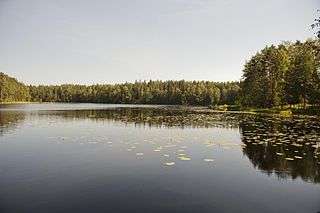
In Finland itself the following make good day trips:
- Nuuksio National Park in Espoo, a piece of untamed wilderness ca 25 km from Helsinki city centre. Accessible by bus from the city.
- Porvoo, the second oldest town in Finland is just 60 km away. It has a charming old town of wooden houses. Much more lively in the summer.
- Tampere, the second largest city region in Finland, and the birthplace of Finnish industry, boasting one of the last Lenin museums left in the world as well as a spy museum. 180 km north of Helsinki, one and a half to two hours by train.
- Hämeenlinna, 100 km to north is famous for the Häme castle, a large medieval castle, and the beautiful park area Aulanko. One hour by train.
- Turku, the oldest town in Finland, the main one into the 19th century, now third largest city region. The cathedral and the medieval castle are well worth visiting. Two hours by train.
- Hanko, the southernmost spot in Finland, 140 km west of Helsinki. This town of less than 10,000 people is famous for its summer activities, including sandy beaches, sailing, tennis, art, theatre, etc.
- Oulu, the biggest city in Northern Finland (as well as whole Northern part of the Nordics). Known as the biking and IT capital of Finland and easily accessible from Helsinki, only an hour's flight away. Flights start from €30 if bought months in advance. The fastest day train takes 6 hours, from €25 if bought in advance, sleepers available in the overnight trains.
As a coastal city, Helsinki has good connections to some fine international destinations nearby:
- In Russia, Saint Petersburg, "the Venice of the North", is one of the most beautiful cities in the world. Accessible by St. Peter Line's overnight cruise ferry departing a few times a week – or by train.
- Stockholm, the Swedish capital, is somewhat like Helsinki but more Scandinavian and bigger. Accessible by Viking Line's and Silja Line's overnight cruise ferries departing late in the afternoon around the year.
- Tallinn in Estonia is known for its medieval city centre and is easily accessible even as a day trip.
| Routes through Helsinki |
| Tampere ← Hyvinkää ← | N |
→ END |
| Turku ← Espoo ← | W |
→ Porvoo → Vaalimaa |
| Lahti ← Vantaa ← | N |
→ |